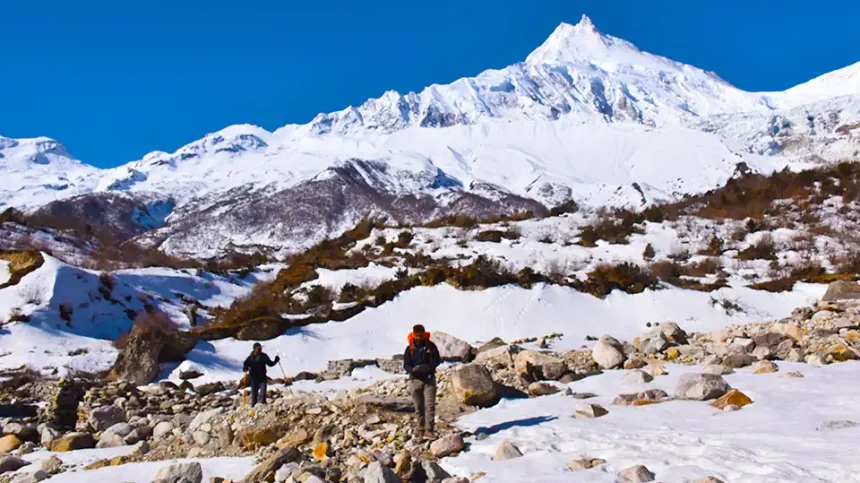The Manaslu process trek is a journey through lovely Himalayan surroundings and a possibility to examine the herbal range of the region. The circuit passes through Manaslu Conservation Area, which was established in 1998 to assist the inhabitants holding the specific vegetation, animals, and nearby village groups that call this place home. Down here to the upper subtropical level up to the high-alpine areas, you will witness a remarkable variety in flora and fauna. This amazing flora and fauna is also one of the reasons that Manaslu is being considered as an alternative to those busier treks. It’s a unique chance to visit an unspoiled natural paradise, such as these are disappearing in many places due to mass tourism. The lush ecosystem of the Manaslu Circuit includes all manner of wildlife; vibrant plant life, towering trees, and exotic fauna abound.
Subtropical and Cool Temperate Forest
The initial several days of the Manaslu circuit trek pass through sub-tropical and temperate forests. Lower down, the vegetation is a dense forest of rhododendron, oak, and bamboo. It’s in the spring, though not for very long, when forests bloom with color – rhododendrons painting valleys and mountainsides red, pink, and white. This is an incredible sight and one that adds to the magic of trekking. They can smell the wet earth and flowers. This section of the path is also home to an abundance of birdlife. Watch for colorful wooded area birds like Nepal’s countrywide fowl, the Himalayan Monal, and listen for the call of the Himalayan cuckoo. The thick forest of untamed trees is home to the jungle of small animals and many exciting bugs. As you go, you will have the sounds and the sights of abundant green life around you.
The Alpine Zone and Its Non-complying Vegetation
Mosses and scrub update the alpine region till in reality nothing grows. And out here, you get to look at some of the most unearthly and toughest vegetation on the earth. The plants that grow here have adapted to live in severe conditions like robust winds, extreme temperatures, and cold. Temperatures at the start look like the scene is a desert; however, peer carefully, and there are dozens of lovable little flowers blooming on this vegetation for three or four months of summer.
Nature around Manaslu Circuit
The charismatic species in the area is hard to spot, Naidu said: the snow leopard. But it’s known to be a resident of the high altitude regions around Samagaun and Samdo, where you have some luck spotting one. The other well-known mammals are the Himalayan Tahr – wild goat – which can be seen foraging on the steep rocky cliffs, and also the Blue Sheep (Bharal), which is one of the main food sources of snow leopards and can be sighted here. You may also come across smaller creatures like the Himalayan marmot, which sleeps below ground for a good portion of the year. Another drawcard is the diverse birdlife. Apart from the Himalayan Monal, you could additionally see gamebirds like Tibetan snowcock or birds of prey, including Griffon vulture and many eagles soaring a long way into the deep blue sky above the mountains.
Shielding the fragile ecosystem
The Permit system for the Manaslu Circuit Trekking helps a lot in protecting this delicate region. Are the permits (Manaslu Circuit Trek map and Manaslu Circuit Trek cost) for Conservation? Traders are true representatives of these substances, allowing you to sustain conservation projects immediately from the location, with cash fees that everyone pays for the transport of that commodity. Restricted area. The restricted status is in place to limit the number of tourists to maintain a sustainable presence. In this fragile environment. Now isn’t the time to go all vigilante, though; hikers are also encouraged to exercise the Leave No Trace principles always. Those tips include wearing out trash, staying on marked trails, and valuing local flowers and wild animals. Whilst you comply with those guidelines, you’re helping to ensure the long-term fulfillment of our wildlife and surroundings. PORTER’S five rules AND tips FOR NAVIGATING through A secret garden. Revenues from the allowance fund conservation and network improvement tasks impart direct advantages to each local person and the surroundings.
Network Engagement in Conservation
Those who live on the Manaslu Circuit are an integral part of conservation. Some of the villages are in a nature reserve, and the people who live there treasure their land. The traditional practices and way of life of the original populations have also helped ensure that ecological integrity is preserved. The Manaslu Trek lets you reach out to the same communities and learn uniquely about the relationship between the land and its environment. They are earth guardians, and their knowledge of local flora and fauna is invaluable. Many of the teahouses and lodges that cater for trekkers are owned by local families, who rely upon tourist spending to support their communities – and have, therefore, an economic incentive to keep their environment healthy.
Seasonal adjustments and Their effect
The natural world and plant life visible alongside the Manaslu Circuit range extensively, depending on the time of year. Autumn (September to November) gives clear mountain perspectives and crisp days, but not as the various bright flora seen in spring. With that said, the prime time to see flora and fauna is during the autumn, whilst the animals are still much more active earlier than winter. From March to May, the lower hillsides appear to be burning, but — no!! They are ablaze with rhododendron of many colors. NATURE Boatnistas and photo geeks are having a field day. You see, winters can be harsh, and many species migrate downhill to look for sustenance. Heavy rains (it’s the monsoon season from June through August, when more than a majority of precipitation for the year falls) can make trails difficult to navigate, but they also stimulate an explosion of new plant growth and produce their own kind of green beauty.
The Larkya La Pass and Its Special Surroundings
The top of the best skip on the Manaslu Circuit Trek is a barren, dramatic 5 a meters high. The plant life is restricted to lichens and mosses on the rocks. It’s an area of savage beauty that places on show the dimensions and rawness that characterize Iceland at its maximum elemental. Not like the tremendously sterile juvenile develop, there is more of a sentimental tackle nature here. It’s an area of profound silence and significant open spaces. Air is skinny and the bloodless brutal, but so too are rewards in sweeping views of close-by peaks like Manaslu, Himlung, Cheo Himal, and Annapurna II. The climb to the bypass is an extension of this path of human interpreting, a petrified wooded area of crumbling fossils.
Final Conclusion
The Manaslu Trek has you really communing with nature. As we emerge from lush lower valleys to an incredible alpine pass, something new is introduced every day of our journey as part of this vast and beautiful ecosystem. Manaslu Round Trekking trip also provides a good understanding of the need to protect and appreciate the delicate mountain way of life. By choosing this trip, you will not only be taking up a physical challenge, but you will also be entering an exciting adventure of discovery. The vision of the Himalayan Tahr standing above you on a distant cliff, or the cawing call of one exposing itself to the light among trees, or simple, unassuming alpine flowers, defiant amidst rubblely ground, will stay with you long after this trek is over. Â The altitude gain is great for acclimatization, and the raw beauty of the Himalayas in this region is simply mesmerizing!











Leave a Reply